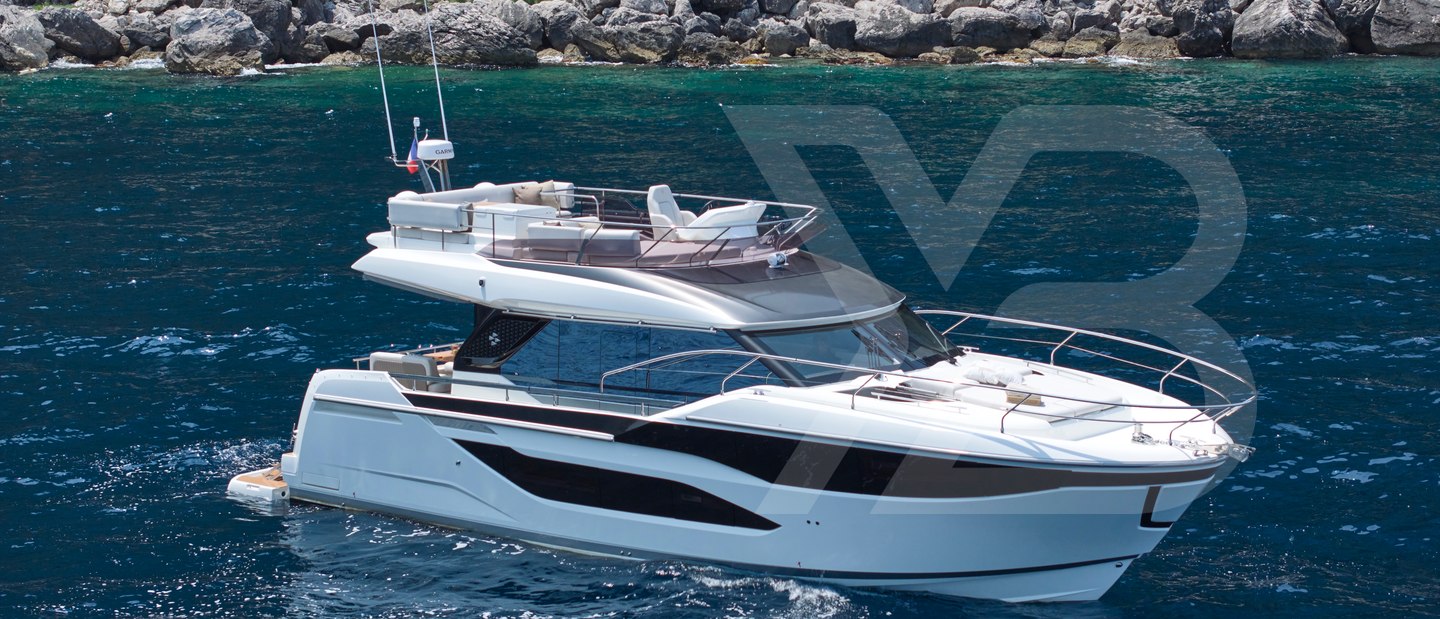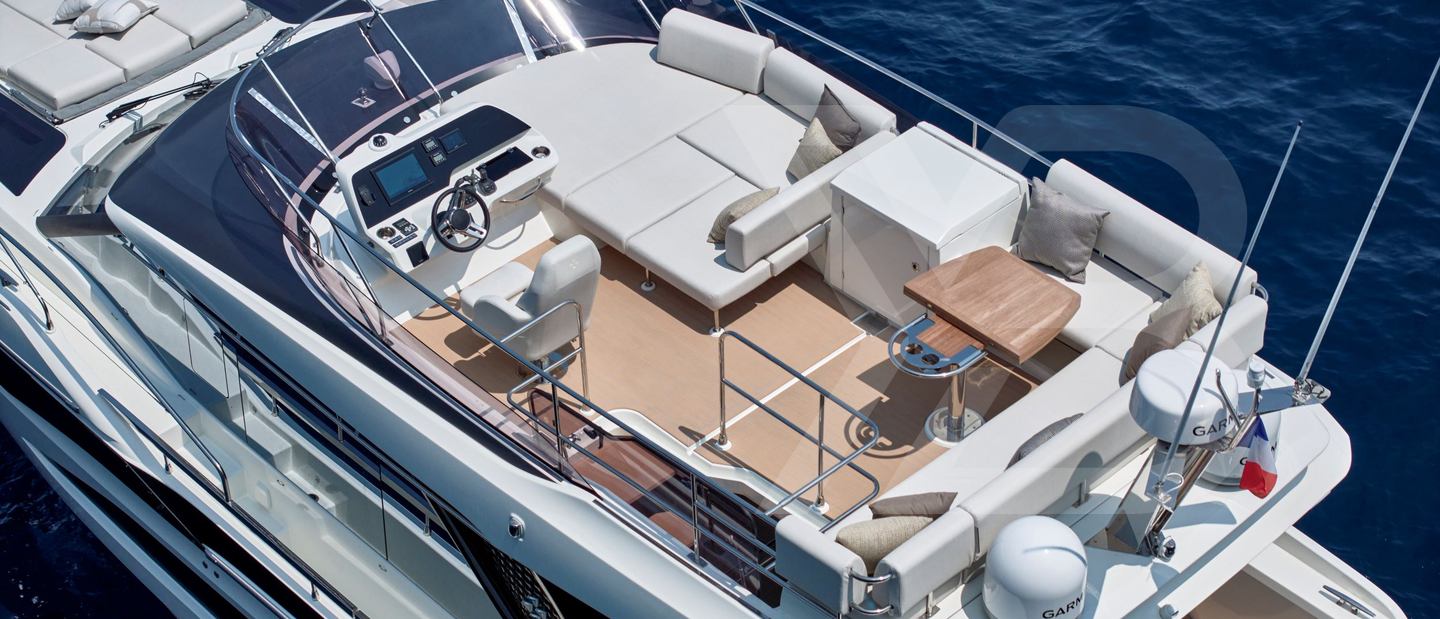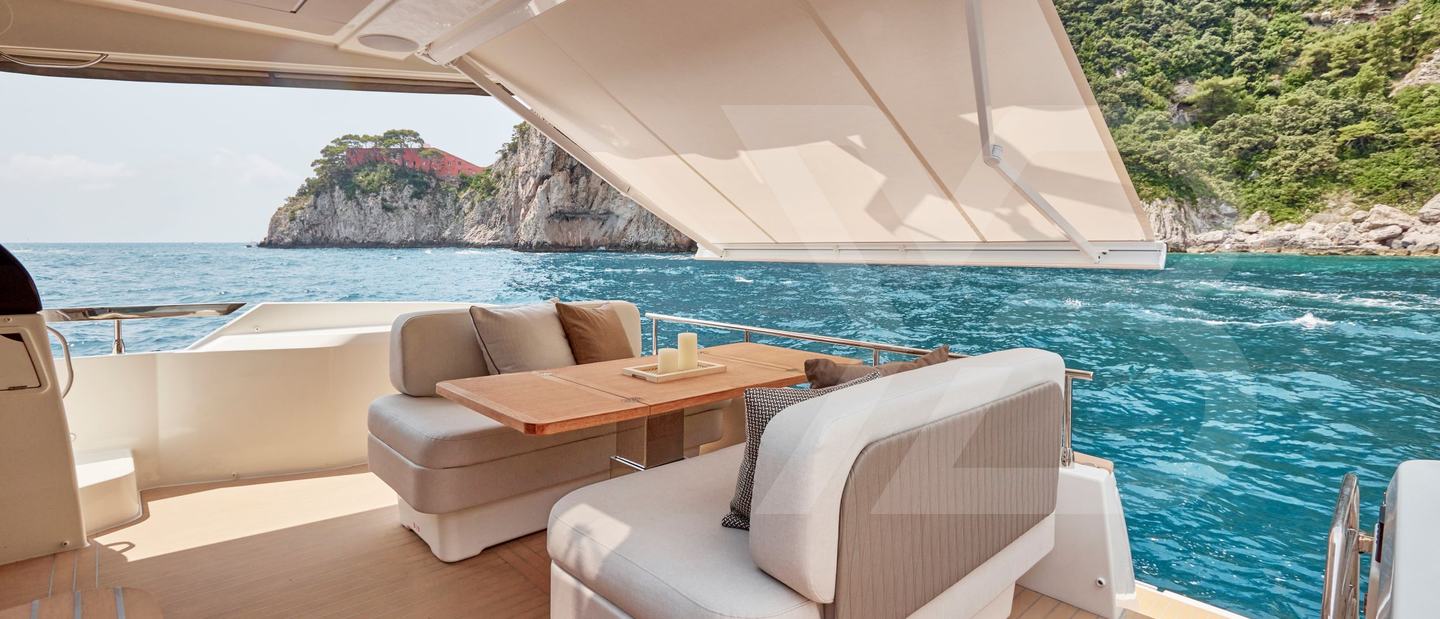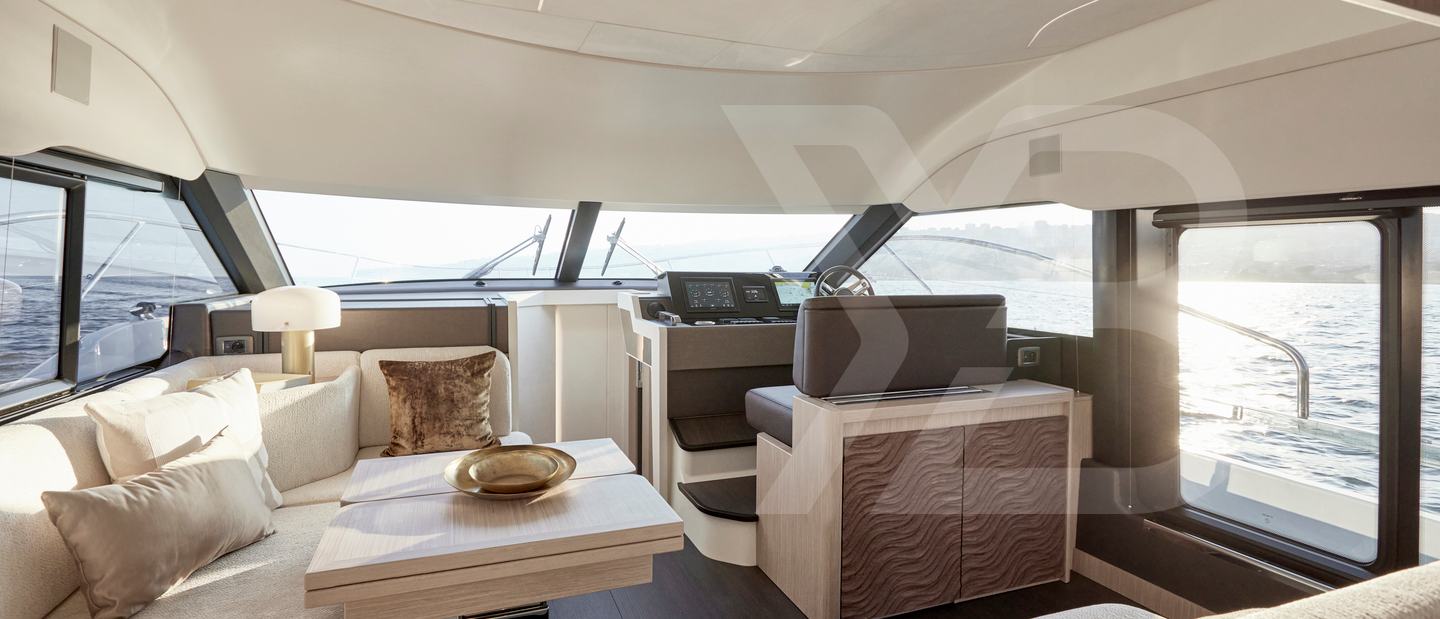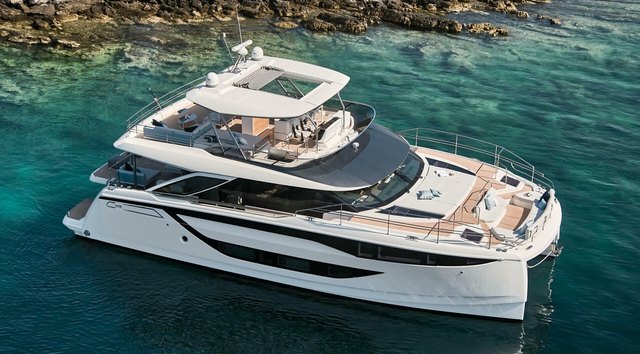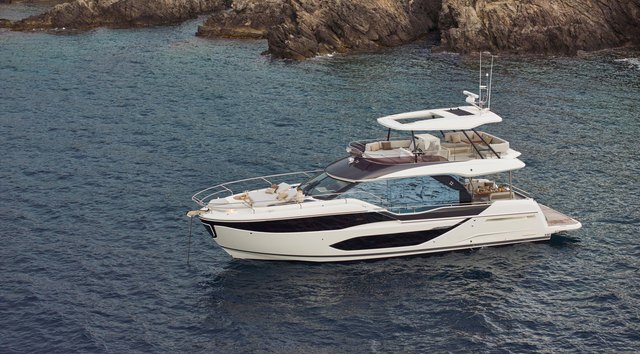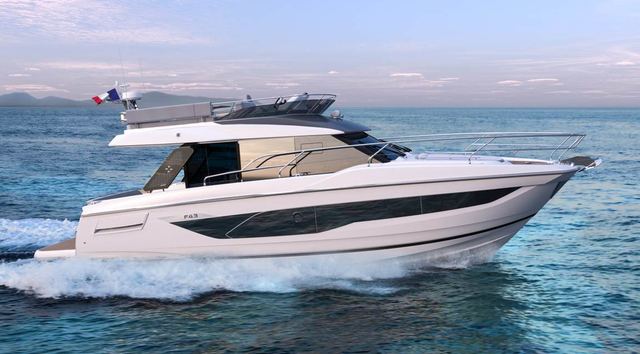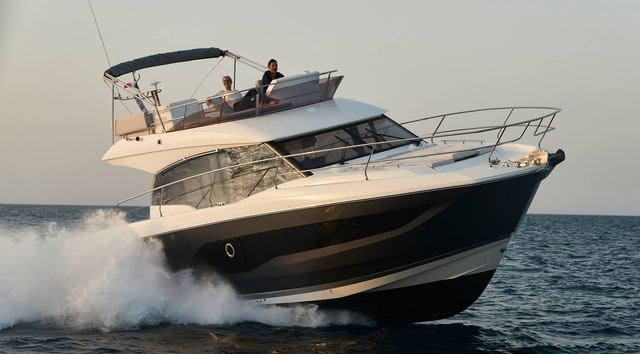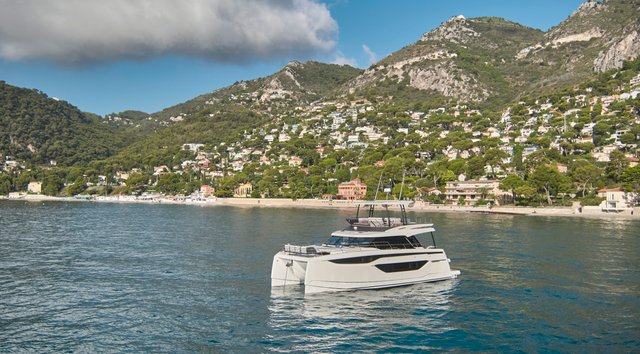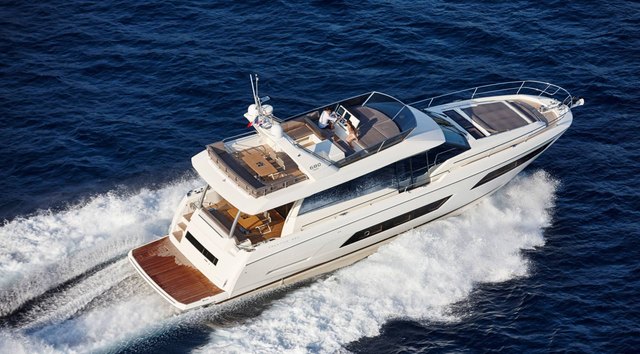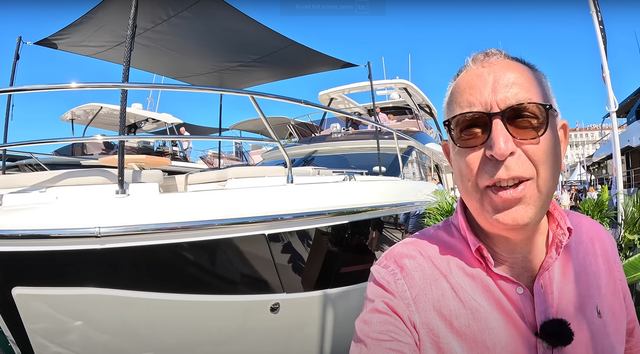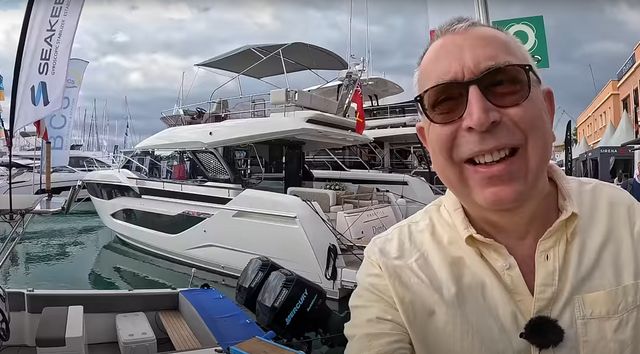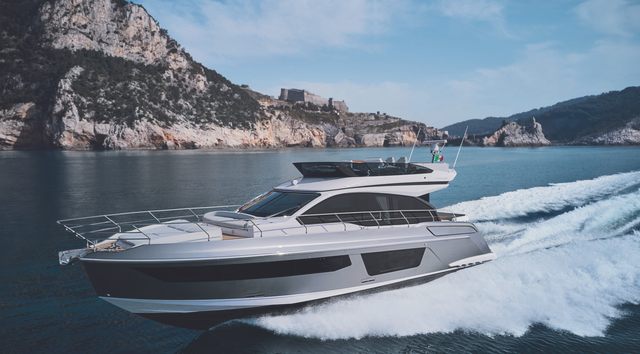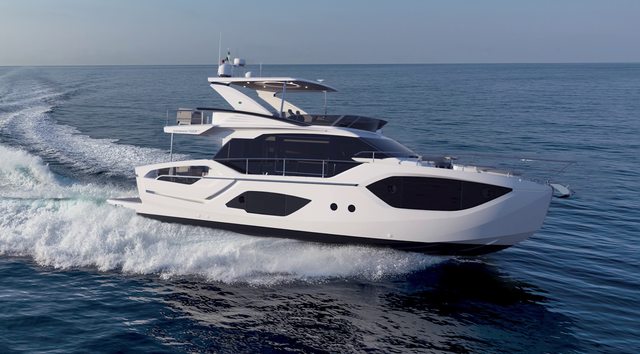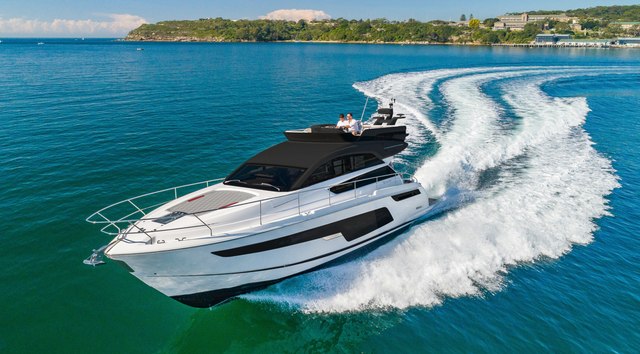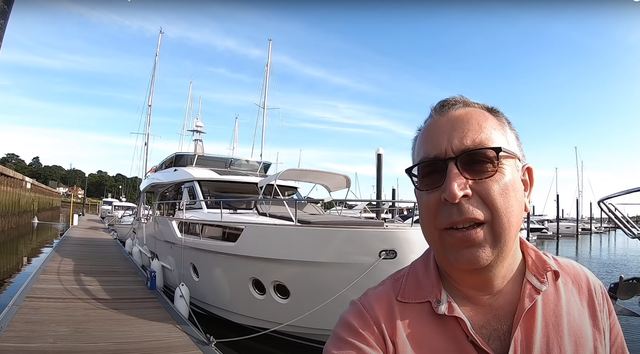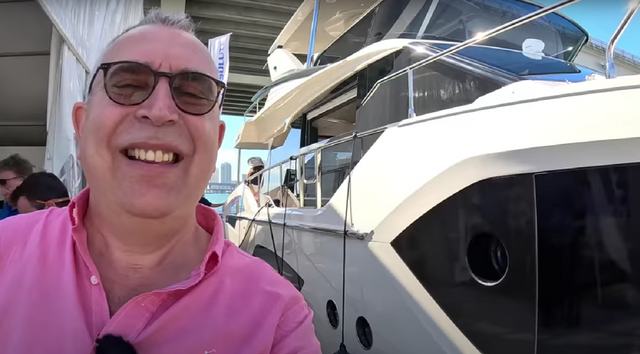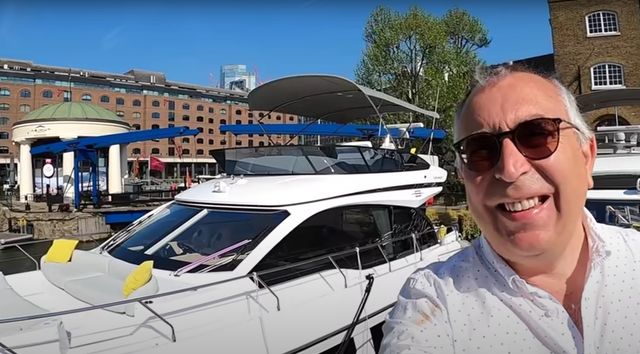Designed in partnership with naval architect Michael Peters and long-time Prestige designer Camillo Garoni, the F4 boasts a striking new look, which will be introduced across the F-Line range, and a return to a forward owner’s suite with two guest cabins amidships.
The spacious owner’s cabin, forward, has excellent headroom and a large ensuite with the VIP and twin guest cabins sharing the space amidships.
On deck, the cockpit seating is arranged along the centre line in a design move first seen in Prestige’s X-Line range and in the saloon, the novel aft galley runs across the saloon rather than along it to create a large, more sociable kitchen space.
Volvo Penta IPS650 (480hp) is the only engine option and will push the Prestige F4 to a top speed just shy of 30 knots and a 22-knot cruise.
Test & Review Video
Around the Marina
The F4 has one IPS engine option and it’s the ubiquitous IPS650 with 480hp per side. The space IPS creates on the lower deck of a boat of this size is invaluable and for a model that will likely be an upgrade from a smaller boat for many, joystick control makes a lot of sense. The engines have plenty of shove to flick the F4 around a marina, though the optional bow thruster is a good addition for extra piece of mind in tight spots.
The majority of berthing will be done from the flybridge because the all-around view is so good. With the helm station on the port side - the opposite side to the lower helm - the skipper can see through the deck hatch to the aft end of the bathing platform, so judging the distance to the quay is easy if mooring stern-to. There is the option to add a third station in the cockpit, which you may want to do if you moor with the stern to the quay regularly.
There is a side door in the saloon but it doesn’t align with the helm station so it’s not as easy to moor from the lower helm as it is on the likes of the Absolute 52 and Galeon 530, which both have big doors in line with the helm.
From the crew’s perspective, it’s an easy boat to move around on with symmetrical access between the bathing platform and cockpit and good fender storage both in the transom and the deep bow locker. The squared-off guardrails, aft, make it a bit trickier to tie fenders but, that aside, it’s a pretty faultless crew experience.
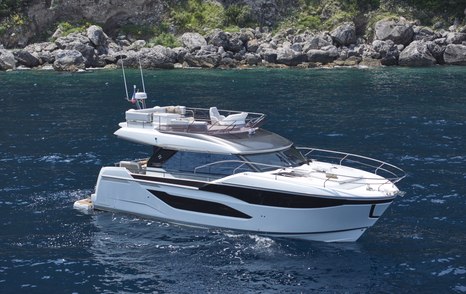

At Sea
The F4 is brand new from the keel up and that includes a fresh hull design from American naval architect, Michael Peters. He has worked with Prestige and across brands in Beneteau Group for some time now and he’s a master of getting the balance between seakeeping and interior volume. Conditions for our sea trial were about as benign as it gets but the calm seas allowed the dynamism and agility of this hull to shine. It’s not a performance boat by any means - the top speed is 28 knots - but the F4 shoots right to the top of the list as one of the most fun boats to drive in the sector.
You might question why that matters on a 50ft flybridge cruiser but if you spot an obstacle in the water and need to take evasive action you will be glad of this F4’s pin-sharp reactions to the helm. Find yourself in a rolling following sea and that combination of responsive handling and the fullness of the bow should make this quite the downwind operator.
The driving position at the upper helm feeds into this sporty behaviour as you sit snuggly in a bucket with your legs outstretched as if driving a sportscar. From here the boat feels alive beneath you and there’s a great sense of how the hull is peeling through the water.


Prestige’s flybridge range is designed to hit about 30 knots flat out and cruise in the early 20s and the F4 is no different regarding performance. The change here is the handling and if this is a blueprint for the dynamic prowess of larger models in the new generation of F-Line then bring them on, this is a lot of fun.
From the lower helm, the experience is more sedate because you’re so well insulated from the conditions and the noise emanating from those 6-cylinder diesel engines nestled beneath the deck. It’s fabulously quiet at cruising speed and even at full chat only just flicks over 75 decibels, so at that slower cruising speed it’s very refined and easy to have a conversation with others in the saloon without having to raise voices.
We tested hull number one, which was pretty much fresh off the line and, despite Prestige insisting it still had tweaks to make, the boat felt as tight as a drum. That isn’t always the case with the first in a new range but then when you build boats in the numbers that Beneteau Group does, you get pretty good at it.
For the F4, the naval architecture and design teams started with a clean sheet of paper. Everything here is new, from the shape of the hull to the exterior lines and materials and finishes adopted inside. There will always be an eye on affordability with a Prestige product but that same improvement in perceived quality that was brought in on the X60 and X80 is clear to see in the newest F-Line model. Catches, handles, upholstery, lighting, and materials all look and feel classier than the last generation of F-Line and up the feeling of quality throughout.
Michael Peters designs a tremendous hull so there shouldn’t be any issues there and Camillo Garoni’s lines are bolder than previous F-Line models. The owner’s cabin is forward on the F4 and that means there needs to be plenty of height and width carried forward to provide the requisite volume. Garoni has disguised this well and cleverly used some rakish hull glazing to break up the bulkiest parts of the molding. The owner's cabin location is one of the major design decisions aboard the F4, and we’ll cover that in more detail in the Interior Accommodation section below.



Engine Room
Access to the engine room is via a hatch in the cockpit floor and the machinery is pretty tightly packed. It’s certainly not as easy to work in as the engine rooms on its rivals from Galeon and Absolute with relatively low clearance over the top of the engines. Checking strainers, filters and levels pre-start-up is easy enough, however, and it’s tidily arranged. The pods are behind a panel, so that will need to be removed if any in-depth work needs to take place and it’s a bit of an awkward clamber to the back of the engine room. On the plus side, big ancillary items of equipment such as the generator and Seakeeper gyro stabiliser are located next to the companionway, so they’re easy to inspect.
Big changes are afoot inside the F4 and one of the most obvious is at the aft end of the saloon. Prestige was one of the first to embrace the aft galley layout in its flybridge boats and the F4s followed suit, with a twist (literally). Here, instead of running along one side of the saloon, the galley stretches from the port side around three quarters of the way across the deck, leaving space for a slim companionway to starboard. An extra wide aft window then pops open on gas rams and clips into the flybridge overhang to open the galley and create a bar between the two areas.
The orientation of the galley breaks up the open plan easy flow of the saloon but it creates a really strong connection between the galley and the cockpit. And, rather than staring at a row of eye-level lockers, the person in the galley has an excellent view out over the aft end of the boat. It also feels like there is more easily accessed storage in this arrangement with both knee and eye-level cupboard storage integrated into the unit that faces the saloon. A domestic fridge/freezer is neatly tucked in at the end of the run of the countertop, though the optional dishwasher will feel a bit pokey if you’re hosting a full boat.
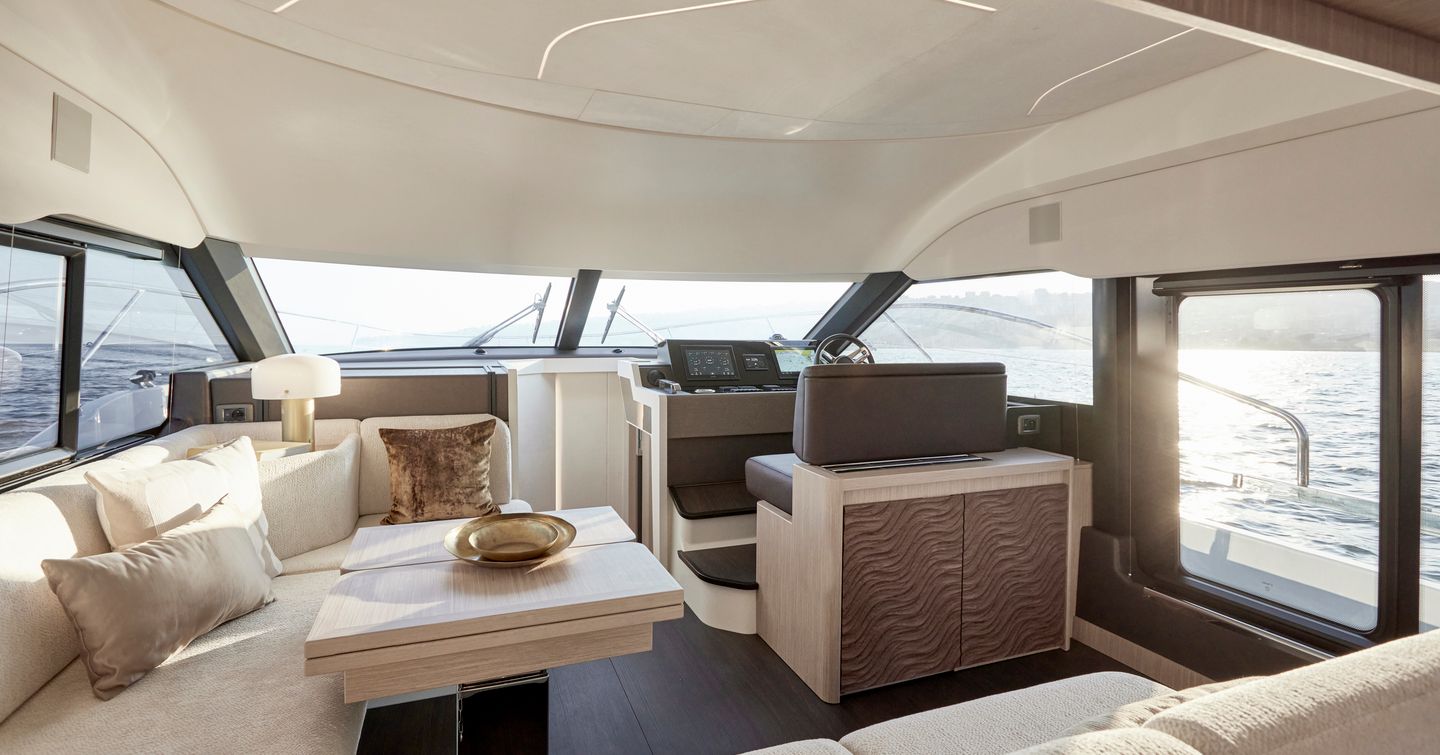


Into the Saloon
With the side door positioned aft of the helm station, there isn’t space for the usual two-seat sofa opposite the main dinette so all of the F4’s interior seating is on the port side of the saloon. It feels like the sort of deep, squishy L-shaped sofa you might have at home, only here there is an electronically adjustable table, which can switch between coffee and dining table height at the flick of a switch. If you’re into your films and treasure a large television that might be a sticking point because the F4s pop up manually from the unit adjacent to the helm, which limits the size somewhat.
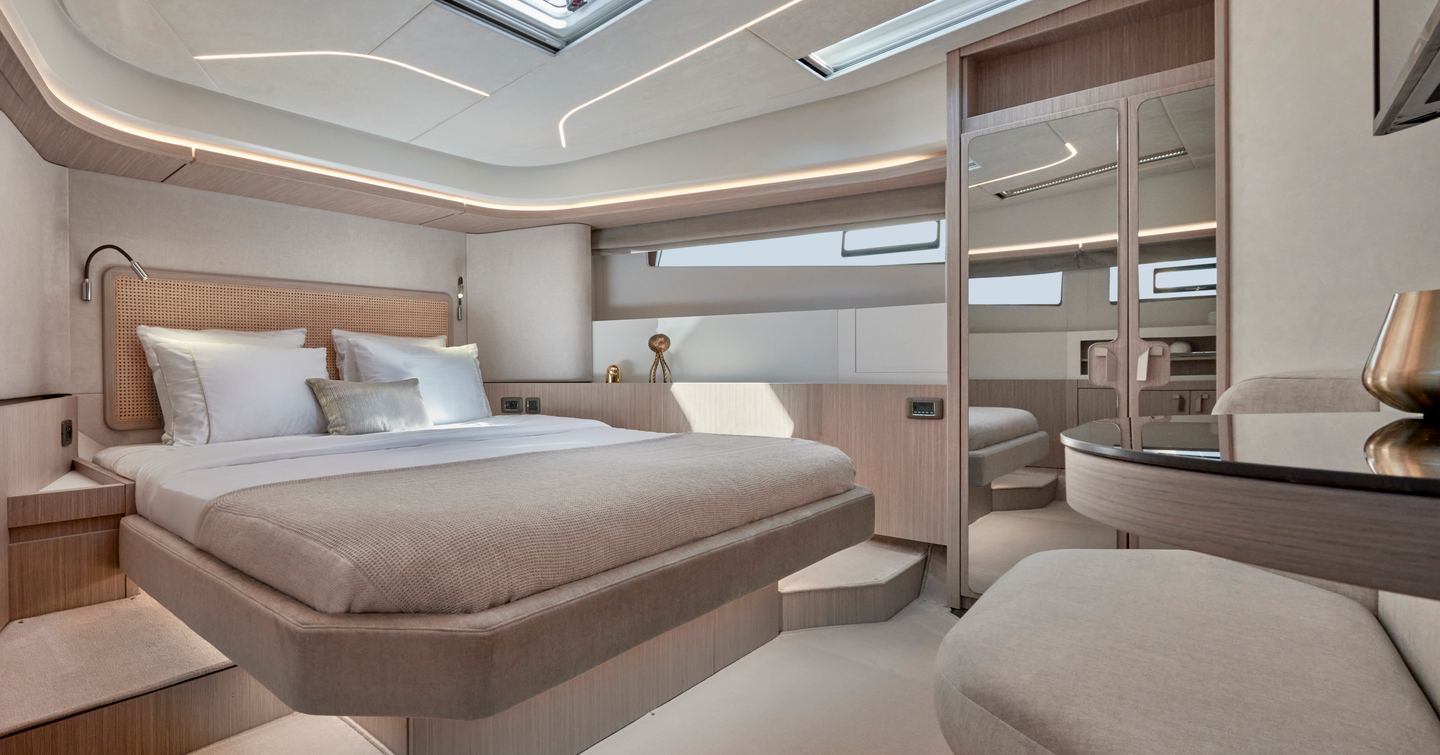
And so to Bed
The biggest design decision on the boat is the position of the owner’s cabin forward, not amidships. Absolute does the same thing with its 52 Fly and it’s an effective layout but, as with most elements of boat design, there are compromises. The benefits include towering headroom, privacy, and the distance between the place where the owner sleeps and the engine room, where there is generally some piece of equipment making noise be that engines, generators, air conditioners, or stabilizers. The hull windows may not be as big as those of an amidships master but forward the design team can bring skylights into play, which draw natural light through the ceiling and offer some natural ventilation. There is also the space to include an impressively large bathroom for a 50-footer, with a big separate shower cubicle and twin sinks.
The compromise is that the guest cabins are bunched together in the space amidships and neither ensuite to the day head, which is positioned just forward. The VIP is to starboard and though it’s not as spacious as the now traditional forward VIP, it’s clever in its layout. The single berths are mounted on runners so you can manually slide them to quickly switch between twins and a double and storage space of all different sizes is abundant. The headroom is a little tight in the lobby for those over 6ft tall but the shared head compartment is a good size and easy to access in the day.


Crew Accommodation
If you plan to run the boat with crew, which, admittedly, is unlikely on a boat of this size then there are probably better options out there. The F4, which is a £3,200 cost option, is a bit of a squeeze to access via a hatch in the aft deck and the space itself is pretty tight with a single berth and small wet room head compartment. It’s probably best to save money and use it as a big, easily accessible storage space.
Let’s start at the upper helm, shall we? It’s a much sportier driving position than you might imagine with a supportive bucket seat that puts you in a comfortable semi-reclined position with your legs out in front as if driving a sportscar. It does lack a bit of adjustment, though, so shorter skippers will find the throttles a stretch. However, Prestige assured us that this is something that it is going to address.
The dash itself is clean and clear if lacking a little flair, but it’s functional and does little to distract from the business of driving. There is only space for one MFD up here and because of that, we would definitely upgrade from the standard 12in Garmin to the 16in one so you have more screen space to display information on.
It is a brilliant driving position and a great place from which you can enjoy the F4’s delightful handling. Despite the high windscreen, there is still quite a lot of buffeting from the wind, however.


Lower Helm
The lower helm is also fixed and it’s not possible to stand and drive but, thankfully the seated position is really good. The throttle rests easily under your right hand and the adjustable wheel is nice and close so it’s easy to sit back in the seat and enjoy the ride.
The view forward is actually very good considering the shallow windscreen, though unlike upstairs you need about ¼ trim tab deployed to maintain the best view forward. Talking of tabs, most of the dash is well laid out but putting the spotlight control next to the throttles and the trim tab buttons on the dash makes no sense, surely the controls you interact with most often should be under the skipper’s hand?
Ventilation is a bit of an issue because though there is a big side door it’s aft of the helm station so those at the helm don’t feel the benefit when the boat is moving and it’s not easy for the skipper to access the side decks as it is on some rivals.
There’s more change on deck where the F4 is the first F-Line model to have the option of opposing cockpit seating. An L-shaped dinette is standard but for €500, the facing seating is so much more sociable and it’s the way that a lot of the boat’s rivals have gone. The open railing atop the transom completes the picture, creating a great view out over the water and the perfect spectator platform for those who don’t fancy a swim.
The standard bathing platform is fixed but most will opt for the hydraulic bathing platform (a £32,500 option), which has a 350kg weight limit and also functions as a launch/recovery platform for the tender. It’s worth pointing out that despite the stated lift capacity, Prestige recommends a tender/engine combination of 150kg so there isn’t too much weight sitting over the back of the boat, something you want to avoid with IPS engines and their aft-biased positioning in the hull.
There is symmetrical access on either side of the transom into the cockpit where it’s easy to pass forward onto the side decks and up to the foredeck. A foredeck is rather simple compared to rivals with a sun pad and pop-up pram-style shade but no sofa or walkway. On the plus side, the wide flat bow does make moving around very easy and there’s plenty of space to handle lines or work the anchor windlass.



Up Top
We tested hull number one and, as usual, there are a handful of tweaks that will be addressed on future units, one of which is adding a bannister to the flybridge steps. At the time of testing, Prestige was also mulling a change of synthetic teak supplier, so the decks may look a little different on future models. Synthetic teak is standard in the F4’s cockpit but it’s a cost option to add it to the side decks and flybridge.
The flybridge isn’t the largest in the class but the deck is sensibly arranged to maximise the space available. There will be a smaller table up here going forward to aid access in and out of the seating, which as standard extends forward along the starboard side of the deck unless you specify the optional wet bar with sink, grill and fridge.
The forward section works well because it converts so easily between extra forward-facing seating on passage and a day bed for when the boat is at rest. Pull out the extensions, drop the cushion in and you have a large sun pad adjacent to the helm.
The top deck is open as standard but there are two shade options; a manual bimini (the one we’d pick) and a fixed hard top. This size of flybridge simply doesn’t suit a fixed hard top and without a sunroof option, you have little flexibility when it comes to shade so the bimini is an easy choice.
The base price for the F4 (at the time of writing) is €890,000 ex VAT but, naturally, the on-the-water price is higher once the options list has been fully explored. The F4, as you would expect from a Beneteau Group product, compares favourably to its rivals in terms of price but as usual, the baseline price doesn’t tell the whole story as there are several extras that pretty much every owner will want to make the boat as comfortable to live with as possible.
There’s room to fine-tune the extras to suit your needs and Prestige helpfully puts some of the boat's desirable items into packages to make the specification process easier, but you’re still looking at north of €1,000,000 ex VAT to get a well-kitted out, turn-key package
Our Options & Pick
The €20,000 Electronics Pack, which includes twin 12in Garmin MFDs at the lower helm, a single 12in MFD at the upper helm, VHF and Autopilot, and the €45,000 Excellence Trim (hi-lo cockpit table, covers for seating and table, spring cleats at the stern, helm side door, 11kW generator, combi microwave/grill, fresh/saltwater wash down) are must-haves in our opinion as they cover off some of the key features in two ticks on the options sheet. The easiest box to tick is the one for facing seating in the cockpit, which is €500 and makes such a difference to the way the aft deck works as a living space.
The hydraulic platform at €36,500 is an expensive option but it’s a fabulous addition for when the boat is on anchor and also serves as an easy way to launch and recover the tender. This is the sort of item that those buying the boat secondhand will be looking for, too, and may overlook a boat that doesn’t have one fitted.
The Strataglass cockpit covers, which fully enclose the aft deck, make sense on a boat of this size because they allow you to extend the protected living area if the weather’s poor. Boaters in areas with less reliable weather will no doubt find this beneficial because it means you’re not restricted to the saloon if the weather turns.
The bow thruster is a €7,350 option but, even with IPS installed, it’s a sensible addition that will give you extra confidence when mooring in tricky situations. Of course, this slightly depends on where the boat is kept but the €56,000 chilled water Mediterranean-spec air-conditioning will be a prerequisite for some. Likewise, the €95,560 Seakeeper 6 is a chunky addition to the boat at this price point but for those who spend lots of time on anchor or hooked to a mooring buoy, it will be worth the outlay for the extra comfort it provides in fighting roll at rest.
Our Verdict
This is such an important boat for Prestige that there was always going to be an element of caution in designing a boat that sets the blueprint for the brand's core series. There is nothing radical here but the subtle updates that have been made make a big difference in combination and not just the obvious things like the new cockpit layout and the position of the owner's cabin. The attention to materials and fabrics is a step up from the model this replaces and there's an edge to the driving experience that has been absent on previous F-Line models. With the usual keen eye on value for money, the F4 is a compelling option and an exciting stake in the ground for F-Line products to come.
Reasons to Buy
- Fresh layout
- Elevated perceived quality
- Value for money
- Good to drive
Things to Consider
- IPS only
- View out from the saloon
- Small flybridge
Looking to own a Prestige F4.9? Use YachtBuyer’s Market Watch to compare all new and used Prestige F4.9 Boats for sale worldwide. You can also order a new Prestige F4.9, customized to your exact specifications, with options for engine choice and layout configuration. Alternatively, explore our global listings of new and used boats for sale and find your perfect boat today!
Rivals to Consider
The F4 is in a congested part of the market and faces stiff competition from some of the biggest production boat builders on the planet. Here's what it's up against.
The Princess F50 is one of the most rounded packages in the sector. It doesn't have the invention of the Prestige, nor does it feel as spacious on board, but it's as if Princess has condensed all of the class and quality of its larger yachts into a perfectly formed 50ft shell. It's dripping with high-end detailing and oozes quality from the depths of the engine room to the beautifully judged interior, which was designed in-house. It has a simple three-cabin, two-bathroom layout comprising an owner's suite amidships, VIP double forward and bunks to starboard. It's one of few IPS boats in the Princess F-Class range, but with the larger IPS800s, it will crack nearly 35 knots flat out.
The Fairline Squadron 50 is a little long in the tooth but it's been a very successful model and the British yard has built a lot of them. It's also an IPS boat with some flexibility on the lower deck where you can have three cabins or two with a lower deck saloon and the option to have the galley up or down. It's another high-quality craft, which may not boast the space of the F4 but is finished to a very high standard and a joy to drive.
The Absolute 52 Fly is bigger and more expensive than the F4 but it shares many of the same design ideas, such as facing seating in the cockpit and the forward owner's cabin. The Absolute's spaces feel grander and the forward cabin arrangement, with the bed aft and the bathroom forward, works better than the F4's. It also has space for a full-beam VIP amidships plus a guest twin. It too is an IPS boat and will achieve the same sort of performance as the Prestige.
The Galeon 500 Fly is the class leader when it comes to deck space, thanks to its optional Beach Club mode. At this size, drop-down balconies really make a difference and the rotating cockpit seating with space below for a Williams Minijet is an excellent piece of design. On board, it has three cabins with the owner's cabin full beam amidships and there is a dizzying array of interior finish choices. It's the same story in the engine room, where you can have IPS of traditional shaft drives. Not the newest model in the sector but it's still a brilliant option that offers many things its rivals don't.
Considering a new boat? Explore Prestige's entire current range to find the model that best suits your needs, and compare it with alternatives from competitors to ensure you make the perfect choice.
Specifications & Performance
Performance Data
Prestige F4.9 version 2023. *Data supplied by the manufacturer.
Test Engines Twin Volvo Penta IPS650
- RPM
- Knots
- Liters Per Hour
- Liters Per Mile
- Range (nm)
- Decibels
-
- ECO
- 1,500
- 7.5
- 19
- 3
- 607
- -
-
- 2,000
- 9.2
- 40
- 4
- 310
- -
-
- 2,500
- 12.6
- 76
- 6
- 224
- -
-
- 2,800
- 15.0
- 99
- 7
- 192
- -
-
- 3,000
- 17.9
- 124
- 7
- 187
- -
-
- 3,200
- 20.6
- 137
- 7
- 200
- -
-
- CRUISE
- 3,500
- 22.7
- 153
- 7
- 206
- -
-
- 3,700
- 25.5
- 168
- 7
- 206
- -
-
- MAX
- 3,750
- 28.4
- 191
- 7
- 186
- -
Yacht Load: 100 Litres of water 100 Litres of fuel
Interested in a F4.9?
NEW Build
Find your local dealer for a personalised, no-cost consultation
or just request
Brochures & Pricing
Used & In Stock
Looking for a ready-to-go F4.9 or pre-owned options? Explore all inventory of the F4.9 available worldwide

